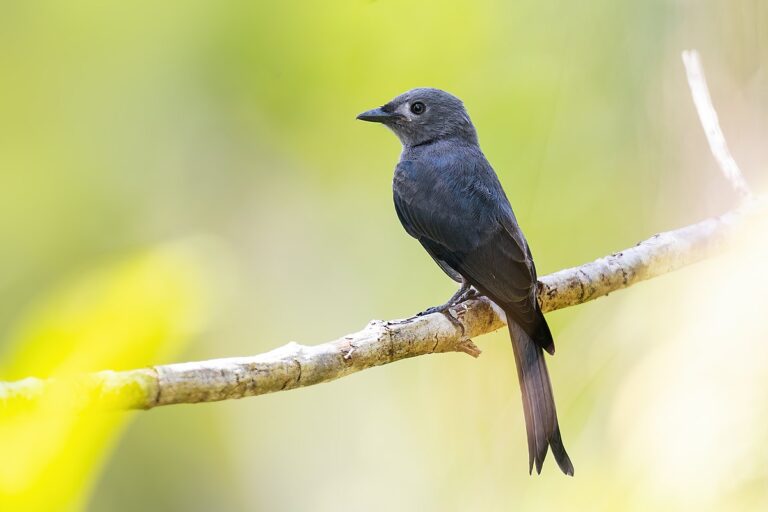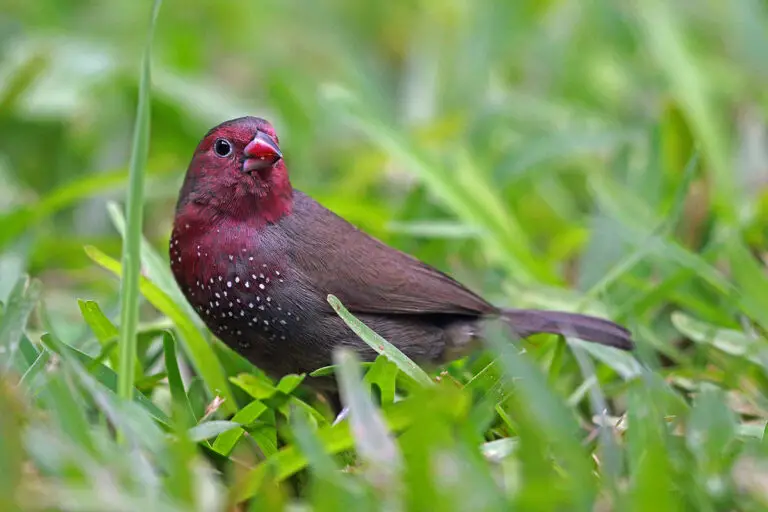Gray Catbird (Dumetella carolinensis)
“Their songs have cat-like qualities and can mimic other birds and animals, like tree frogs.”
Scientific Classification
- Kingdom: Animalia (Animals)
- Phylum: Chordata (Chordates)
- Class: Aves (Birds)
- Order: Passeriformes (Perching Birds)
- Family: Mimidae (Mockingbirds and Thrashers)
- Genus: Dumetella
As for its conservation status, the Gray Catbird is categorized as “Least Concern” by the International Union for Conservation of Nature (IUCN). This means that the species is not currently facing any significant threats to its survival across its range.
Gray Catbirds can be found in various locations across the Americas, including Central America, North America, and South America. Additionally, they have been known to appear in parts of Europe. Their adaptable nature allows them to inhabit a wide range of habitats within these regions.
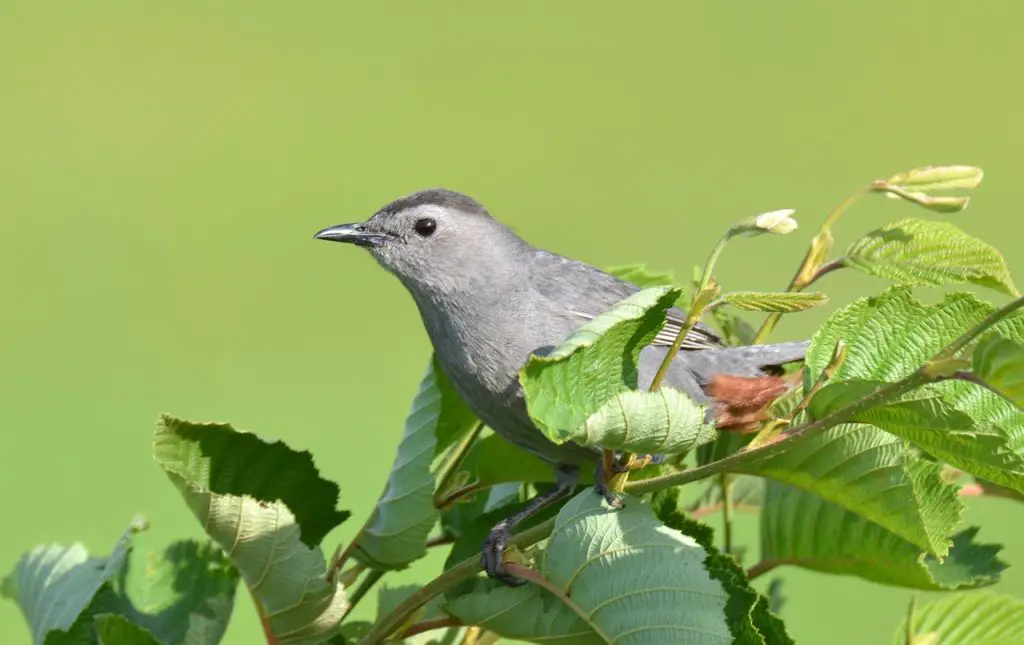
Here’s a summary of facts about the Gray Catbird:
- Prey: Their diet consists mainly of fruit and insects, particularly berries, cherries, grasshoppers, and beetles, with berries being a main prey item.
- Name of Young: The young are called chicks.
- Group Behavior: Gray Catbirds are mainly solitary birds.
- Fun Fact: They have a song with cat-like qualities and can mimic other birds and animals, including tree frogs.
- Estimated Population Size: Approximately 29 million individuals.
- Biggest Threats: Urbanization and climate change pose significant threats to their habitat and survival.
- Most Distinctive Feature: Lead-gray plumage.
- Distinctive Features: Long tails and straight, narrow bills.
- Wingspan: Ranges from 8.7 to 11.8 inches.
- Incubation Period: 12 to 13 days.
- Age of Fledgling: Typically 10 to 11 days.
- Habitat: They inhabit scrublands, woodland edges, and overgrown farmlands.
- Predators: Predators include snakes, rats, cats, foxes, and squirrels.
- Diet: They are omnivores.
- Lifestyle: Diurnal (active during the day).
- Type: They are birds.
- Common Name: Gray Catbird.
- Special Features: They possess a songbird syrinx.
- Location: Found in North America and Central America.
- Average Clutch Size: Typically around 4 eggs.
- Nesting Location: Nests are usually found in dense shrubs and thickets.
- Migratory: Yes, they are migratory birds.
Physical Characteristics:
- Color: Gray with black and dark gray accents.
- Skin Type: Covered in feathers.
- Lifespan: Approximately 6.3 years.
- Weight: They weigh between 0.8 to 2 ounces.
- Length: Their body length ranges from 8.1 to 9.4 inches.
- Age of Sexual Maturity: They typically reach sexual maturity at one year of age.
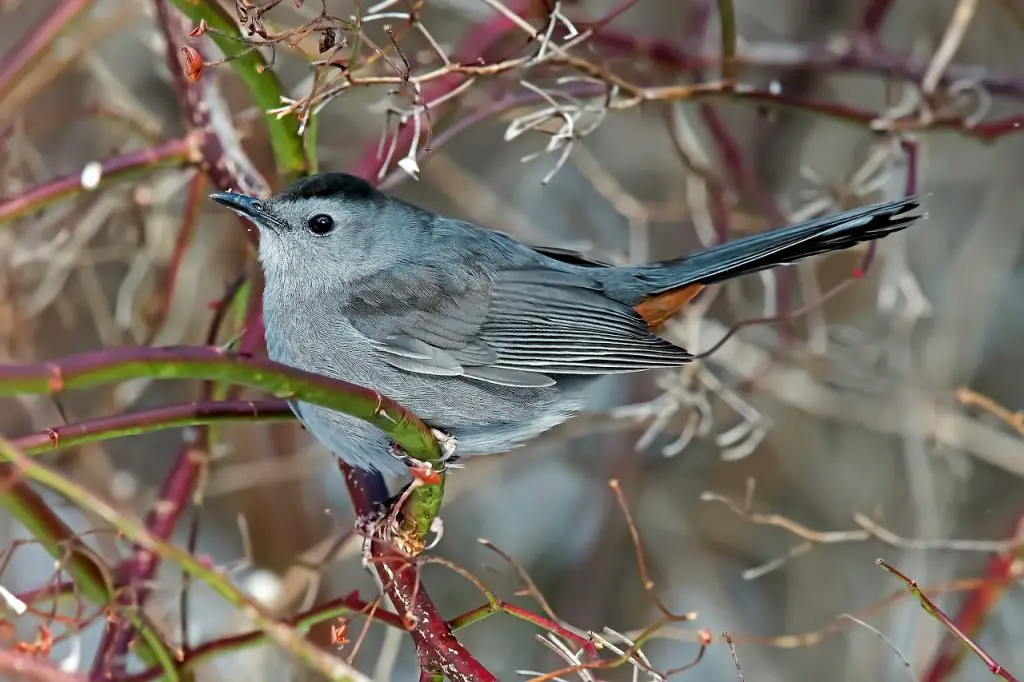
5 Amazing Gray Catbird Facts
Here are five amazing facts about the Gray Catbird:
- Transatlantic Travelers: Despite being native to North America, Gray Catbirds occasionally undertake impressive transatlantic journeys, with some individuals finding their way to Western Europe during migration.
- Feline-like Serenades: Their songs are not only melodious but also have cat-like qualities, giving them a unique vocal charm. Additionally, they possess the remarkable ability to mimic other birds and animals, including the croaks of tree frogs.
- Dual Vocal Talent: Equipped with a specialized vocal organ called a syrinx, Gray Catbirds can produce two distinct sounds simultaneously, adding complexity and richness to their songs.
- Year-round Defenders: Unlike many bird species that become less territorial during the winter months, Gray Catbirds maintain their territorial behavior throughout the year, displaying aggression even in colder seasons—a behavior uncommon among most birds.
- Fruity Feasts: Half of the Gray Catbird’s diet comprises fruit and berries, highlighting their importance as seed dispersers within their ecosystems. This preference for fruit contributes to their role as key players in maintaining the balance of plant communities.
Where to Find the Gray Catbird
The Gray Catbird’s range spans across North America, encompassing over 20 countries including Canada, the United States, Mexico, Puerto Rico, and Jamaica. This species is migratory, with breeding grounds in the temperate regions of the United States and Canada, and wintering grounds in the Southeastern United States, Mexico, Central America, and the Caribbean. While they primarily reside in North America, they are known as extremely rare vagrants to Western Europe.
Catbirds are typically found in habitats characterized by dense vegetation, such as scrublands, woodland edges, overgrown farmland, and abandoned orchards. During the winter months, they tend to inhabit thickets near water sources where plenty of berries are available. When searching for Gray Catbirds, look for them low to the ground as they hop along thick vegetation. Their presence may be indicated by their distinctive mechanical and raspy mimicry, which they use to communicate and conceal themselves within bushes and trees.

Gray Catbird Nest
Indeed, Gray Catbirds exhibit a particular nesting behavior. Here are some details about their nesting habits:
- Nest Placement: Gray Catbirds typically place their nests between three to ten feet above the ground. They prefer dense shrubs, thickets, and briar tangles as nesting sites, providing cover and protection for their offspring.
- Nest Construction: The female Gray Catbird takes the lead in building the nest. She constructs a large, bulky cup-shaped nest using a variety of materials including twigs, leaves, grass, weeds, and sometimes even bits of trash or other found objects. This diverse material helps to provide structural support and insulation for the nest.
- Nest Lining: Inside the nest, the female lines it with finer materials such as softer grasses, plant fibers, or even animal hair if available. This lining helps to create a comfortable and cozy environment for the eggs and later the hatchlings.
By selecting well-concealed locations and constructing sturdy nests, Gray Catbirds ensure the safety and security of their offspring during the nesting period.
Scientific Name
The Gray Catbird (Dumetella carolinensis) belongs to the Mimidae family, which includes a diverse range of New World birds such as catbirds, thrashers, mockingbirds, and tremblers. Members of the Mimidae family are renowned for their exceptional vocal abilities and their capacity to mimic a wide variety of species, including other birds and sometimes even non-avian sounds.
The genus name, Dumetella, is derived from Latin and translates to “thorny thicket,” which aptly describes the habitat preference of the Gray Catbird and its tendency to sing from concealed undergrowth.
The specific epithet, carolinensis, originates from New Latin and means “from the Carolinas.” This likely refers to the historical observation of the species in the Carolinas region of the southeastern United States.
Notably, the Gray Catbird is monotypic, meaning it is the sole recognized species within its genus and has no recognized subspecies. This reflects the unique and distinct characteristics of the species across its entire range.
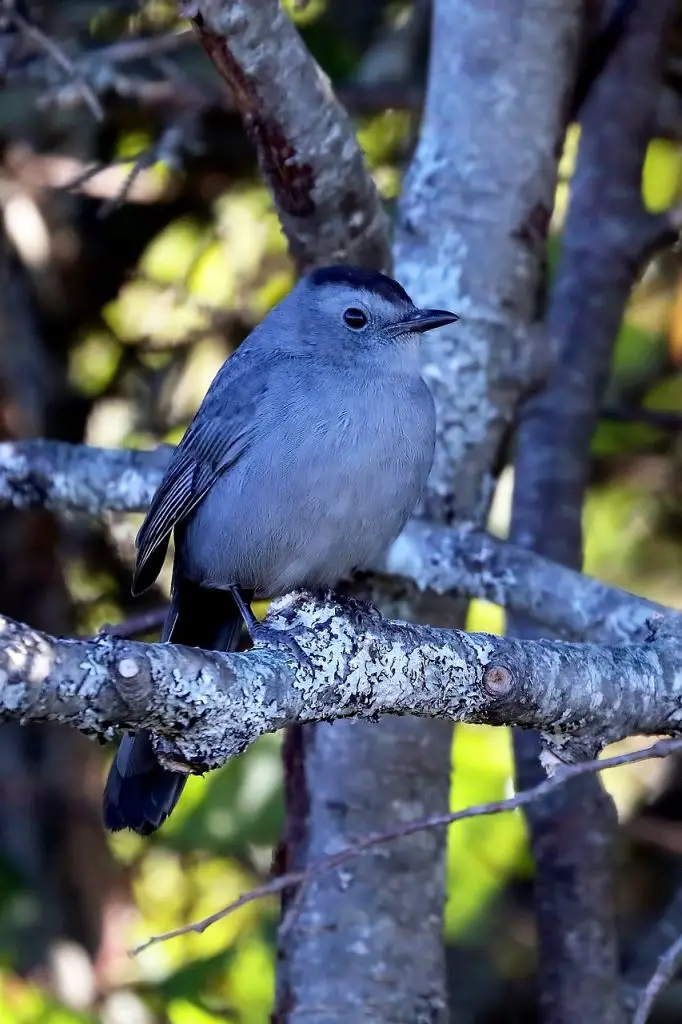
Size, Appearance, & Behavior
The Gray Catbird is a captivating medium-sized passerine bird, characterized by the following physical attributes:
- Size: Typically measuring between 8.1 to 9.4 inches in length.
- Weight: Weighing between 0.8 to 2.0 ounces.
- Wingspan: Exhibiting an impressive wingspan ranging from 8.7 to 11.8 inches.
- Body Structure: They possess long, rounded tails, straight and narrow bills, long legs, and broad wings.
- Coloration: The entire body is adorned in a lead-gray color, while the top of the head, tail, and wing remiges tend to be darker, ranging from gray to black.
- Sexual Dimorphism: Males and females appear similar in appearance, with juveniles being plainer and often featuring buffy undertails.
Beyond their physical characteristics, Gray Catbirds are known for their unique vocalizations and behavior:
- Vocal Abilities: Named for its cat-like call, they are skilled mimics, capable of imitating various bird species and even non-avian creatures like tree frogs. Their voice is distinctive, with a raspy mechanical quality.
- Songbird Syrinx: Equipped with a specialized vocal organ called a syrinx, Gray Catbirds can produce two sounds simultaneously, adding complexity to their vocal repertoire.
- Singing Behavior: They prefer to sing from within the cover of bushes rather than perching openly on branches.
- Behavior: During the day, they can be observed hopping through low vegetation and undertaking short flights. Despite their unassuming size, they exhibit territorial and aggressive behavior, even during the winter months. They are known to defend their territories vigorously, sometimes running off intruders and even destroying the eggs and nestlings of other woodland bird species.
Overall, the Gray Catbird’s combination of physical attributes, vocal prowess, and behavior make it a fascinating and unique member of the avian community.
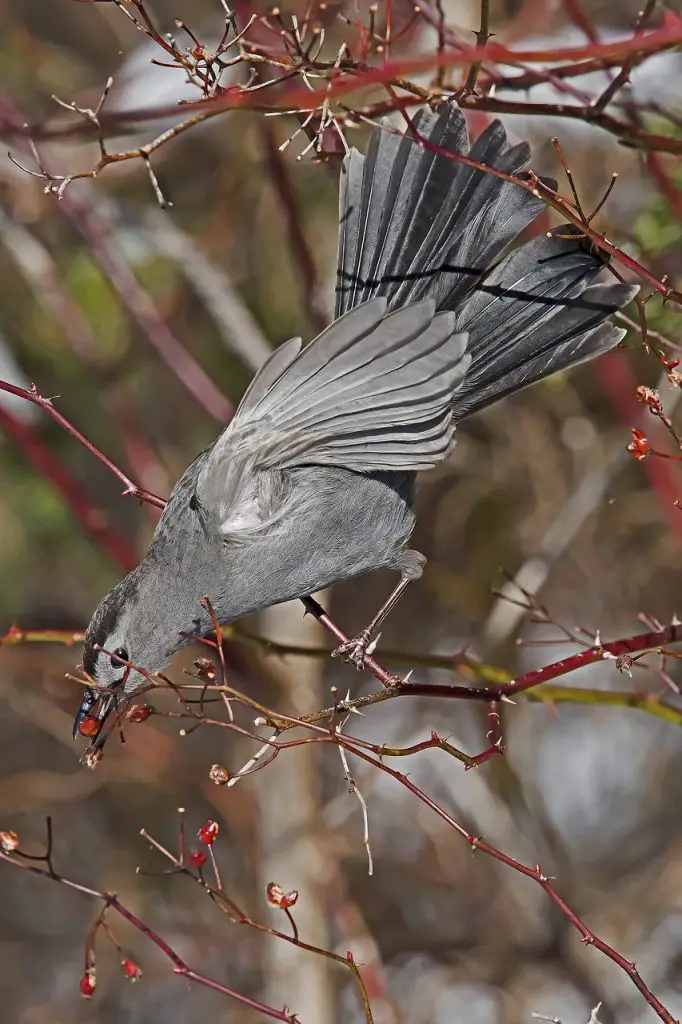
Migration Pattern and Timing
Gray Catbirds are indeed widespread breeders throughout much of the United States, with the exception of the West Coast. During the breeding season, they can be found in a variety of habitats across their range, including woodlands, scrublands, and suburban areas, where they build their nests and raise their young.
Come winter, Gray Catbirds undertake migratory journeys to warmer regions, particularly to the Gulf Coast states from Florida to Texas, as well as to Central America and the Caribbean. These migratory populations seek out more favorable wintering grounds with abundant food resources and milder climates.
However, it’s essential to note that not all Gray Catbird populations migrate. Along the US East Coast, some populations are nonmigratory and remain in their breeding territories year-round. These individuals are well-adapted to the local conditions and can endure the winter months without needing to undertake long-distance migrations.
Diet
Indeed, Gray Catbirds have a diverse diet, making them omnivorous birds. A significant portion of their diet, approximately half, consists of fruits and berries. This preference for fruits and berries plays a crucial role in their ecological niche as seed dispersers within their habitats. By consuming fruits and berries, Gray Catbirds help to spread seeds, contributing to the dispersal and regeneration of plant species.
In addition to fruits and berries, Gray Catbirds also feed on a variety of other food items, including insects, spiders, and other small invertebrates. During the breeding season, they may increase their intake of protein-rich insects to meet the demands of feeding their young. This dietary flexibility allows Gray Catbirds to exploit a wide range of food sources, making them adaptable and successful in various environments.
What Does the Gray Catbird Eat?
Absolutely, Gray Catbirds exhibit a varied diet that includes both fruits and insects. Here’s a breakdown of their dietary preferences:
Fruits: Gray Catbirds consume a variety of fruits, including holly berries, cherries, blackberries, and elderberries. These fruits are often abundant in their habitats during the appropriate seasons, providing essential nutrition for the birds. Gray Catbirds play an important role in dispersing the seeds of these fruits as they forage.
Insects: During the summer months, Gray Catbirds rely more heavily on insects for their diet. They consume a wide array of insects, including grasshoppers, ants, beetles, worms, and other bugs. Insects provide valuable protein and nutrients, especially during the breeding season when adult birds require additional energy for raising their young.
Foraging Behavior: Gray Catbirds exhibit specialized foraging techniques depending on their dietary preferences. When searching for berries, they forage in shrubs and trees, plucking fruits from branches or foliage. For insects, they often forage on the ground, flipping aside leaves and debris to uncover hidden prey items. This diverse foraging behavior allows Gray Catbirds to efficiently exploit both fruit and insect resources within their habitats, contributing to their overall success as omnivorous birds.

Predators, Threats, and Conservation Status
The International Union for Conservation of Nature (IUCN) categorizes the Gray Catbird as “Least Concern” (LC). This designation is assigned because the species has a broad geographic range and a large, stable population, which does not currently meet the criteria for being classified as threatened or endangered.
While the Gray Catbird does not face immediate threats to its survival, it may be vulnerable to future challenges posed by urbanization and climate change. These factors can have indirect impacts on the bird’s habitat and well-being:
Urbanization: As urban areas expand, natural habitats suitable for Gray Catbirds may be lost or fragmented. This loss of habitat can reduce available nesting sites and foraging areas, potentially affecting breeding success and population dynamics.
Climate Change: Climate change can pose various risks to Gray Catbirds and their habitats. Spring heat waves, for example, can increase temperatures to levels that endanger the young birds in their nests. Additionally, extreme weather events such as wildfires can destroy large areas of habitat, further fragmenting populations and reducing available resources.
While the Gray Catbird is currently considered a species of least concern, ongoing monitoring and conservation efforts are crucial to ensure its long-term survival. Protecting and preserving its diverse habitats, as well as addressing broader environmental issues such as climate change, will be essential in safeguarding this species and other wildlife for future generations.
What Eats the Gray Catbird?
Gray Catbirds face predation from a variety of animals, including snakes, rats, cats, foxes, squirrels, chipmunks, raccoons, blue jays, crows, and grackles. These predators primarily target catbird eggs and chicks, although their success rates vary.
To mitigate the risk of predation, Gray Catbird parents employ several strategies:
- Nest Placement: They strategically hide their nests within extremely dense shrubbery, making them difficult for predators to locate. This dense vegetation provides natural camouflage and protection for the nest and its contents.
- Camouflage: The gray plumage of Gray Catbirds serves as effective camouflage as they move through the shadows of dense vegetation. This helps them evade detection by predators while foraging or tending to their nests.
- Defensive Behavior: While Gray Catbirds are not afraid to confront predators, they may also employ distraction techniques to protect their nests. They may flash their wings and tails while emitting “mew” sounds, drawing the attention of predators away from the nest site.
Despite these defensive measures, predation remains a significant threat to Gray Catbirds, especially during the vulnerable stages of nesting and fledgling. Their ability to adapt their nesting behavior and employ defensive strategies helps increase their chances of successfully raising offspring in the face of predation pressure.
Reproduction, Young, and Molting
Gray Catbirds indeed exhibit fascinating breeding behavior, characterized by monogamous pair bonds and elaborate courtship rituals. Here’s a breakdown of their breeding habits:
- Pair Bonds: During the breeding season, Gray Catbirds form monogamous pair bonds. These bonds are typically maintained throughout the breeding period, with both partners contributing to nesting and raising offspring.
- Courtship: Courtship behaviors among Gray Catbirds include singing, chasing, posturing, and bowing. These displays serve to strengthen the pair bond and establish breeding territories.
- Brood Production: Gray Catbird pairs often produce two broods per breeding season, allowing them to raise multiple sets of offspring. This strategy increases their reproductive success and ensures the continuation of their genetic lineage.
- Egg Laying: Female Gray Catbirds typically lay an average of four eggs per clutch, although clutch sizes can vary and range from two to six eggs. The eggs are greenish-blue in color and are incubated by the female alone for approximately 12 to 13 days.
- Parental Care: Both parents participate in feeding and caring for the nestlings once they hatch. They bring a variety of insects and other food items to the nest to ensure the healthy growth and development of their offspring.
- Fledging: After about 10 to 11 days of hatching, the young Gray Catbirds fledge the nest. They are still dependent on their parents for food and protection during this time but gradually become more independent as they learn to forage on their own.
- Sexual Maturity: Gray Catbirds typically reach sexual maturity around one year of age, at which point they are capable of breeding and contributing to the next generation.
- Lifespan: On average, Gray Catbirds live for about 6.3 years. However, individual lifespans can vary depending on factors such as predation, habitat quality, and environmental conditions.
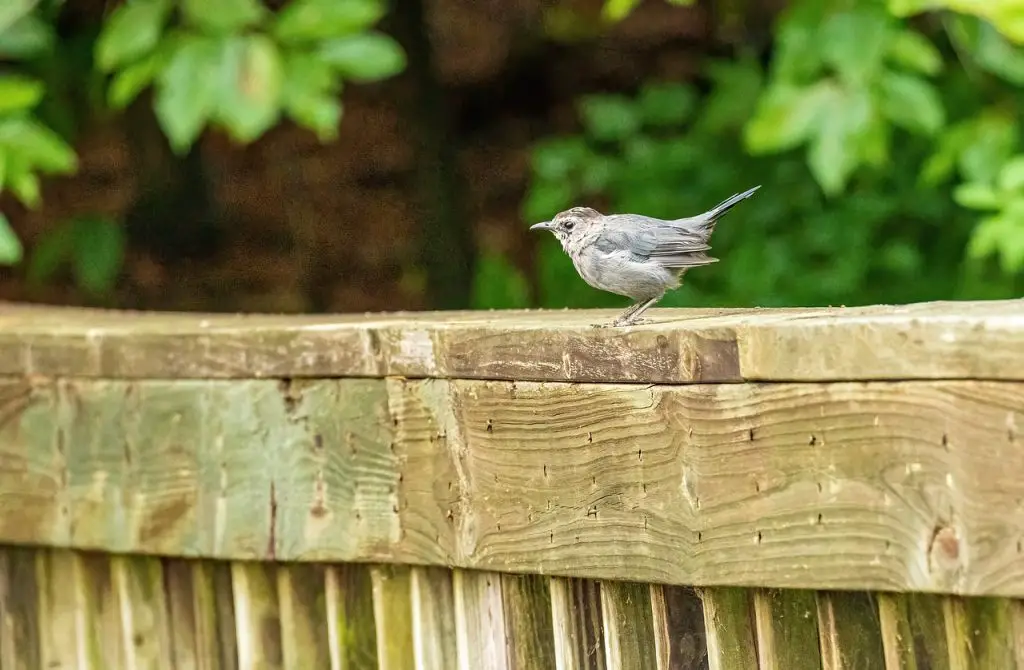
Overall, the breeding biology of Gray Catbirds showcases their adaptability and resilience as they navigate the challenges of reproduction in their natural environment.
Population
The global population of Gray Catbirds is estimated to be around 29 million mature individuals. This population size reflects the combined numbers of Gray Catbirds across their range in North America and possibly extends to their wintering grounds in Central America and the Caribbean.
Over the past four decades, the population trends of Gray Catbirds in North America have been stable. This indicates that there have been no significant declines or increases in their numbers during this period. Additionally, there are no indications of extreme fluctuations or fragmentations in their population size, suggesting that Gray Catbirds maintain relatively stable and healthy populations across their range.
The stability of Gray Catbird populations is a positive sign and suggests that they are not currently facing any major threats or challenges to their survival. However, continued monitoring and conservation efforts are necessary to ensure the long-term sustainability of their populations, particularly in light of potential future impacts from factors such as habitat loss, climate change, and other human-induced pressures.
Before You Go…
The Gray Catbird, with a global population estimated at 29 million mature individuals, demonstrates stable population trends over the past four decades in North America. These birds are not experiencing significant fluctuations or fragmentations in their numbers, indicating a resilient species. While their stable populations are a positive sign, continued monitoring and conservation efforts are essential to ensure the long-term survival of Gray Catbirds, particularly in the face of potential threats such as habitat loss and climate change.
Reference:
